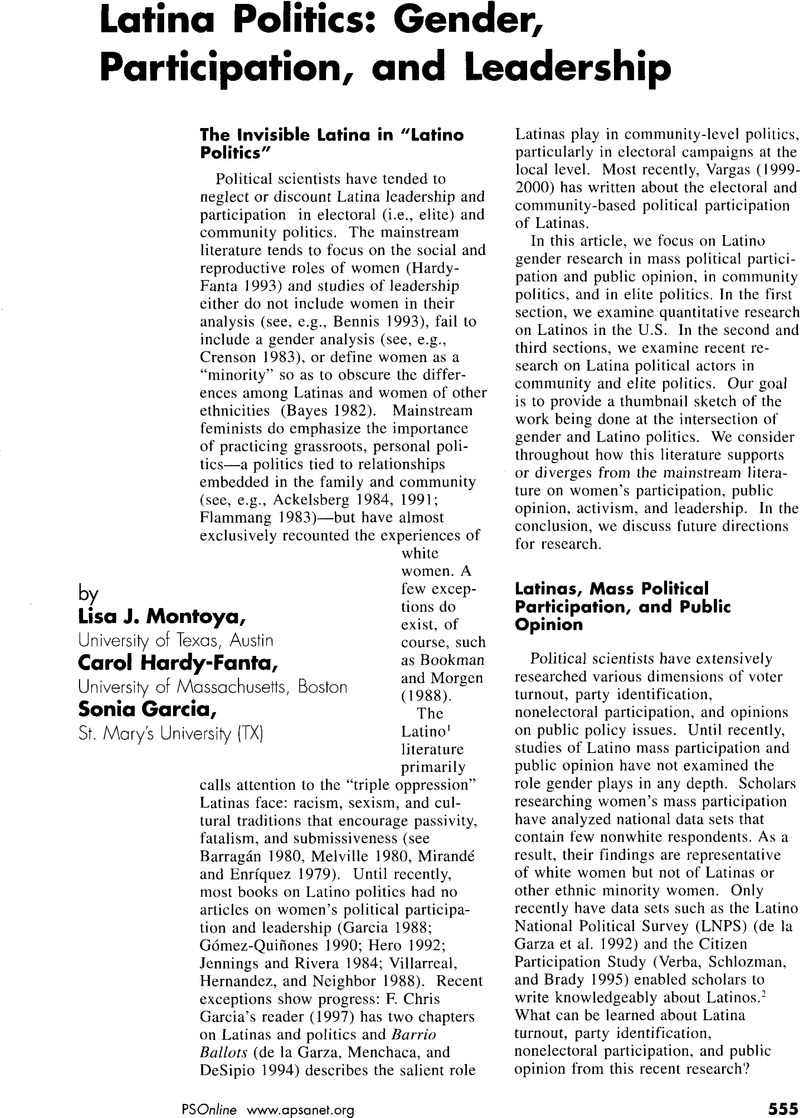Crossref Citations
This article has been cited by the following publications. This list is generated based on data provided by Crossref.
García, Sonia R.
and
Márquez, Marisela
2001.
Motivational and Attitudinal Factors Amongst Latinas in U.S. Electoral Politics.
NWSA Journal,
Vol. 13,
Issue. 2,
p.
112.
Prindevillem, Diane-Michele
2003.
'I've Seen Changes'.
Women & Politics,
Vol. 25,
Issue. 1-2,
p.
89.
Trounstine, Jessica
and
Valdini, Melody E.
2008.
The Context Matters: The Effects of Single‐Member versus At‐Large Districts on City Council Diversity.
American Journal of Political Science,
Vol. 52,
Issue. 3,
p.
554.
Hughes, Melanie M.
2013.
The Intersection of Gender and Minority Status in National Legislatures: The Minority Women Legislative Index.
Legislative Studies Quarterly,
Vol. 38,
Issue. 4,
p.
489.
Hughes, Melanie M.
2013.
Diversity in National Legislatures Around the World.
Sociology Compass,
Vol. 7,
Issue. 1,
p.
23.
Lavariega Monforti, Jessica
and
Cramer, Renee Ann
2014.
Guarding Our Borders with Gardasil: Immigrant Women and Physical Autonomy.
Journal of Women, Politics & Policy,
Vol. 35,
Issue. 1,
p.
1.
Brown, Nadia E.
2014.
Political Participation of Women of Color: An Intersectional Analysis.
Journal of Women, Politics & Policy,
Vol. 35,
Issue. 4,
p.
315.
Silber Mohamed, Heather
2015.
AmericanaorLatina? Gender and identity acquisition among Hispanics in the United States.
Politics, Groups, and Identities,
Vol. 3,
Issue. 1,
p.
40.
Ginieniewicz, Jorge
2015.
Argentine Migrants to Spain and Returnees: A Case for Accumulation of Civic Assets.
International Migration,
Vol. 53,
Issue. 1,
p.
148.
Lacomba, Cristina
2016.
Gender and Politics in Comparative Perspective: The Case of Ecuadorean Immigrants in Madrid and New York City.
Social Politics: International Studies in Gender, State & Society,
Vol. 23,
Issue. 4,
p.
531.
Caraballo, Krystlelynn
2020.
From Victim to Criminal and Back: The Minority Threat Framework's Impact on Latinx Immigrants.
City & Community,
Vol. 19,
Issue. 2,
p.
315.
Igiebor, Oluwakemi
2021.
Women, academic leadership and the ‘constricting’ gender equity policies in Nigerian universities: an integrated feminist approach.
Journal of Higher Education Policy and Management,
Vol. 43,
Issue. 4,
p.
338.
Acosta, Alan A.
and
Guthrie, Kathy L.
2022.
Haciendose un Líder: Leadership Identity Development of Latino Men at a Predominantly White Institution.
Journal of Hispanic Higher Education,
Vol. 21,
Issue. 1,
p.
112.
Phillips, Christian Dyogi
2023.
Intersectional Opportunities: Majority Minority Districts and the Descriptive Representation of Latinas and Latinos.
The Journal of Politics,
Vol. 85,
Issue. 2,
p.
496.
Espinoza, Katherine
and
Degollado, Enrique David
2023.
”You Just Want to Start Trouble”: A Chicana Bilingual Maestra’s Trenza of Her Path Towards Conocimiento.
Equity & Excellence in Education,
Vol. 56,
Issue. 1-2,
p.
144.
Simien, Evelyn M.
Hayes, Thomas J.
and
Conway, Carolyn
2024.
The Democratic Majority and the 2016 American Presidential Election: Feminist Political Behavior Across Multiple Axes of Identity.
Political Research Quarterly,
Vol. 77,
Issue. 1,
p.
371.
Gatti, Rosa
Buonomo, Alessio
and
Strozza, Salvatore
2024.
Immigrants’ political engagement: gender differences in political attitudes and behaviours among immigrants in Italy.
Quality & Quantity,
Vol. 58,
Issue. 2,
p.
1753.
García-Albacete, Gema
Núñez, Lidia
Sánchez, David
Abendschön, Simone
and
Kleer, Philipp
2025.
Beyond Gender: Exploring the Intersectional Dynamics in Political Interest Among Youth.
Politics and Governance,
Vol. 13,
Issue. ,



